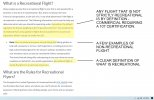AnzacJack
Australian Defence Veteran
The nature of the camera has nothing to do with it. If the purpose of the flight is for commercial gain, then its a commercial flight.
If its pulling a banner to advertise a business, its commercial even without a camera
No loophole
If its pulling a banner to advertise a business, its commercial even without a camera
No loophole











